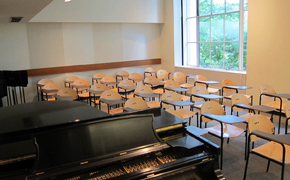This Course at MIT pages are part of the OCW Educator initiative, which seeks to enhance the value of OCW for educators.
Course Overview
This page focuses on the course 21M.065 Introduction to Musical Composition as it was taught by Prof. Keeril Makan in Spring 2014.
This course is one of several introductory music subjects offered at MIT for which no prior formal training is assumed. It uses a hands-on approach to composition as a means to explore sound, listening and music.
Course Outcomes
Course Goals for Students
- Investigate the sonic organization of musical works and performances, focusing on fundamental questions of unity and variety.
- Use written composition assignments to develop musical ideas and notation methods that effectively transmit to performers.
Listening is one of the greatest gifts we can give to somebody.
—Prof. Keeril Makan
In the following pages, Prof. Makan gives more details on how he teaches 21M.065 Introduction to Musical Composition.
Curriculum Information
Prerequisites
None
Requirements Satisfied
HASS-A ![]()
Offered
Every spring semester
Assessment
The students' grades were based on the following activities:
 50% Sequence of 10 composition assignments
50% Sequence of 10 composition assignments 20% In-class participation
20% In-class participation 20% Final project
20% Final project 10% One-page responses to weekly listening and reading
10% One-page responses to weekly listening and readingInstructor Insights on Assessment
Read how Professor Makan made purposeful pedagogical decisions about the composition assignments.
Student Information

Breakdown by Major
Students tend to be in the pure sciences, Math or Mechanical Engineering. This semester we had three Nuclear Science and Engineering majors for the first time. We have Music majors as well.
Typical Student Background
Typically 50% of students are able to read music, and 50% cannot. Many students who cannot read music play music in some way. Some students have experience singing with a cappella groups or are singers in other capacities. There are typically a few students who have backgrounds in electronic music.
There are also students with no training or experience in music. Those are often times the most interesting students—particularly those who think they don't like music, and take the course to test that preconception.
In future iterations of this course, we may experiment with offering two sections: one section for students with some training and experience in music, and one for students without this background.
Enrollment Cap
Limited to 18.
During an average week, students were expected to spend 12 hours on the course, roughly divided as follows:
In Class
Met 2 times per week for 1.5 hours per session. Class activities were a mix of lecture/discussion and student demonstrations of their composition assignments.
Out of Class
Reading and listening assignments and composition assignments. Occasional attendance required at concerts and composer forum events.
Semester Breakdown
| WEEK | M | T | W | Th | F |
|---|---|---|---|---|---|
| 1 |  |  |  |  |  |
| 2 |  |  |  |  |  |
| 3 |  |  |  |  |  |
| 4 |  |  |  |  |  |
| 5 |  |  |  |  |  |
| 6 |  |  |  |  |  |
| 7 |  |  |  |  |  |
| 8 |  |  |  |  |  |
| 9 |  |  |  |  |  |
| 10 |  |  |  |  |  |
| 11 |  |  |  |  |  |
| 12 |  |  |  |  |  |
| 13 |  |  |  |  |  |
| 14 |  |  |  |  |  |
| 15 |  |  |  |  |  |
| 16 |  |  |  |  |  |
 No classes throughout MIT
No classes throughout MIT Class session
Class session Forum discussion
Forum discussion Assignment due date
Assignment due date Project presentations
Project presentations No class session scheduled
No class session scheduled Artist in Residence session
Artist in Residence session Individual meetings
Individual meetings Concert or talk held outside class hours
Concert or talk held outside class hours

 Room 1 of 1
Room 1 of 1 